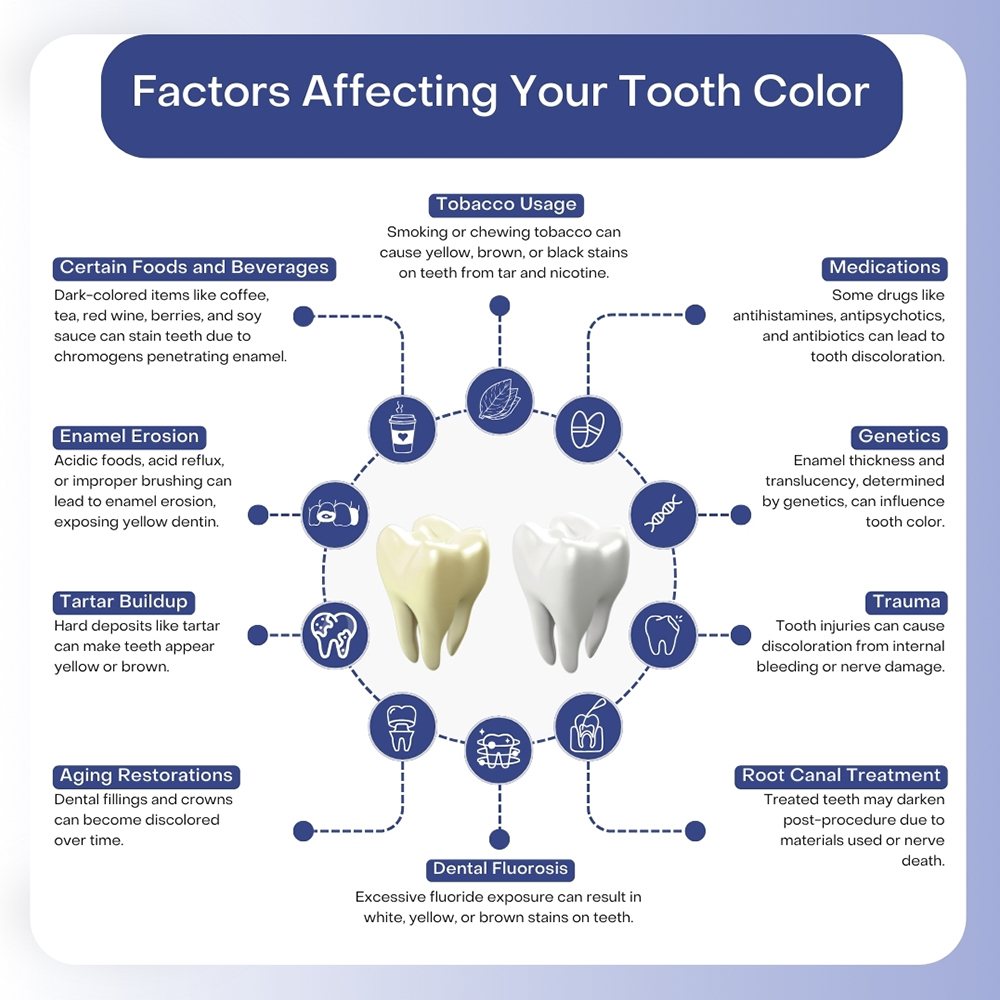Table of contents
Teeth whitening is a procedure that can remove deep-seated stains, brighten the appearance of teeth, and provide you with a smile you will love to show off. Beautiful white teeth are often considered a sign of youthfulness; discolored and stained teeth can detract from an otherwise attractive smile. Teeth can be discolored even when strong, healthy, and well-maintained.
Various factors can influence the overall color of your teeth, including the following:

Do you love tomato-based sauces or curries, or can’t live without your coffee? Colored foods and drinks can penetrate tooth enamel, causing staining and discoloration. If a food or beverage stains your clothes, it will almost certainly stain your teeth.
Smoking or using any tobacco products can leave you with yellow or brown-stained teeth. In addition, smoking increases your risk of gum disease, oral cancer, and bad breath.
Certain antibiotics can leave brown stains on teeth. These medicines include tetracycline.
If your parents or siblings have darker teeth, you will likely share a similar tooth color. There is a considerable variety of different tooth enamel shades in nature. Very few people have naturally white teeth.
A blow to the mouth can damage the innermost part of the tooth, called the pulp. The pulp contains the tooth nerve, blood vessels, and connective tissues. Damage can cause bleeding and discoloration or affect the nerve so that it dies and gradually darkens, staining the tooth internally.
An older root canal treatment can cause tooth discoloration. This type of stain is internal.
Some people are exposed to excess fluoride while their adult teeth are still developing. This can cause white or brown stains on teeth that, although unsightly, are entirely harmless. Usually, this condition is due to drinking unregulated water supplies, such as well water.
Older restorations like dental bonding or tooth-colored composite resin fillings can stain over time. Porcelain restorations do not stain but can begin to look old and may benefit from replacement.
Plaque is continually building up over tooth surfaces. Most of this sticky biofilm is removed during brushing and flossing. If it isn’t, plaque soon hardens into tartar or calculus, which happens in just a few days. Tartar can soon form a hard, yellowish, crusty layer around the gum line, and it can quickly become stained and look unsightly.
Over time, the protective outer layer of tooth enamel that coats each tooth gradually thins as you age. Enamel is slightly opaque, and more of the natural tooth color shines through when it thins. Your natural tooth color, in the dentin underneath, is darker, making it appear as if teeth are stained.
Enamel is eroded by overbrushing teeth with a hard-bristled toothbrush. More often, it is due to acids found in foods and beverages or produced by plaque bacteria.
We know numerous whitening products are available over the counter and online, but if you want the best teeth whitening experience, see a cosmetic dentist. As you have learned, numerous factors can affect your tooth color. Only a professional dentist can examine your mouth and determine why your teeth have stained and how best to remedy this problem.
When you come and see us, we can:
My New Jersey Dentist uses high-quality professional strength whitening products. These products are effective, fast-acting, and safe for your teeth. They contain ingredients like fluoride to help protect your teeth and to reduce tooth sensitivity. You cannot purchase these products over the counter as they must only be used and prescribed by a dental professional.
After determining whether teeth whitening is suitable, we can discuss which treatment to use. We can offer two options for external tooth stains affecting tooth enamel: an in-office whitening treatment or a custom home-whitening kit. Both are effective and affordable.
An in-office treatment is the quickest. Your teeth will be several shades brighter in as little as an hour. During treatment, your gums and lips are protected, and teeth are coated with professional strength whitening gel containing hydrogen peroxide. The gel is light-activated to achieve faster penetration of the tooth enamel, oxidizing and lifting deep-seated stains. The process may be repeated several times during treatment.
Your teeth may continue whitening for up to a week afterward as your tooth enamel settles down. It is more porous during this time, so it is important to avoid consuming highly colored foods and beverages for the first few days. We can provide more detailed information and advice at the time.
A custom home whitening kit is equally effective but will take around two weeks to achieve full results. This option can be good if your teeth are a bit more sensitive, as you can use a lower-strength whitening gel and bleach your teeth at your own pace.
Your kit will include trays made to fit your teeth precisely. These can be re-used later when you need to top up the results. We will prescribe carbamide peroxide whitening gel, a more stable form of peroxide that is safe for use.
We will show you how to fill and insert the trays and recommend when and how long to wear them. Some people like to leave the trays in overnight. Others prefer to use them for a few hours each day.
Your smile should remain looking good for several months. Lifestyle habits like smoking or consuming lots of highly colored foods and beverages will result in teeth staining more quickly. We can advise you on when to have a top-up treatment safely.
It is important to use all teeth whitening products as directed, including any purchased over the counter. Overusing them can damage your teeth and gums and will not make your teeth look any whiter. Instead, your teeth can look overbleached, lifeless, dull, and gray.
Professional teeth whitening treatments using hydrogen peroxide applied topically to the tooth enamel are very effective. However, a tooth is sometimes stained internally, and this intrinsic staining may require a different treatment approach, for example, through trauma or root canal treatment. We can determine if a tooth is internally stained during your initial dental examination and suggest other treatments.
Sometimes, it is possible to bleach a tooth from the inside. Otherwise, covering the tooth with a porcelain veneer or dental bonding may be preferable.
Teeth bleaching is one of our most requested treatments. We can ensure you whiten your smile effectively and, above all, safely. Schedule your consultation to learn how we can rejuvenate your smile, giving it a brighter, more youthful appearance affordably.

My name is Victoria Kushensky. I am a general dentist dedicated to remaining at the forefront of my field. Combining compassionate care with extensive knowledge, I offer cosmetic and general dentistry services as well as advanced root canal treatments.
I earned my Doctor of Dental Surgery (DDS) degree from the esteemed New York University College of Dentistry. Throughout my career, I have honed my skills in various dental procedures, ensuring effective treatment for each patient’s unique needs. I prioritize patient comfort and understanding, taking the time to thoroughly explain procedures and address any questions.
More about Dr. KushenskyMy NJ Dentist: Victoria Kushensky, DDS
385 Prospect Ave Suite 304
Hackensack, NJ 07601
(201) 298-8000